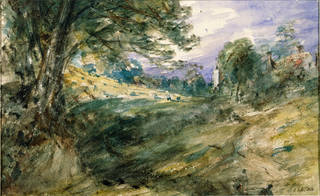Freelance paper conservator Melissa Lewis takes a closer look at some of the watercolours and drawings made by John Constable (1776 – 1837) after 1829, exploring what they reveal about his techniques and process.
Constable is well known for his use of oil sketches to capture and record nature in the moment. However, after 1829, he preferred working with watercolour.


Constable was said to be a man wholly engrossed in practising art. Yet, when his wife died in 1828, he took on the responsibility for raising seven children alone, deeply saddened. In July 1834, following a period of mourning and illness, John visited his friend and fellow artist George Constable at Arundel and went to paint the surrounding area, including Findon Wood and Petworth, by invitation of Lord Egremont.

In his letter of 16 July 1834 to his friend and biographer Charles Leslie, Constable describes the scenery he encountered on his visit:
The Castle is the chief ornament of this place – but all here sinks to insignificance in comparison with the woods, and hills. The woods hang from excessive steeps, and precipices, and the trees are beyond everything beautifull [sic]: I never saw such beauty in natural landscape before. I wish it may influence what I do in future, for I have too much preferred the picturesque to the beautifull – which will I hope account for the broken ruggedness of my style.
Traditionally, watercolour is made up of transparent pigments built up in gentle washes over light paper. By contrast, Constable's pictures of the Sussex countryside are vigorous and experimental. In Cottages on a high bank (1834 – 5), Constable has started using opaque pigments. He experiments with different brushes, using a coarse-haired brush (made from hog hair or similar) to produce thick, shadowy details. He also uses the end of the handle of his brush to score and abrade the paper, removing paint and bringing fine touches of light to dark areas, as can be seen on the farmhouse roof in A farmhouse and church at Houghton, Sussex (1834).


In other sketches, Constable draws over light blue washes of colour with grey pencil lines and plain water washes to create mood and shadow in the sky. In View over Hilly Country, with a Stormy Sky (about 1830), he uses the side of a graphite stick to produce the effect of sheets of rain hitting the hill. Cottages on a high bank (1834 – 5) exploits a low horizon line, so you can feel the long climb up the hill to the cottages on the bank. The paint is thickly applied with a variety of brushes, textures and tones. It is a quick energetic picture, yet he perfectly captures the feeling of warmth on the left hand field as the clouds open up and bathe the hillside in sun.


In Fittleworth Mill and Bridge, on the Rother, Sussex (1834), Constable employs a technique that he may have found useful when painting with oil on paper. He has applied a 'size' (a thin coating of transparent gelatine) or possibly 'isinglass' (a very pure version of traditional gelatine, made using the dried swim bladder from a sturgeon fish), which is painted over the top of the drawing with the addition of mica (a silicate mineral ground to a powder) to add a definite sparkle.

In The ruins of the Maison Dieu, Arundel (1835), he draws with thick graphite pencil, heavily worked all over the page, sometimes so forcefully that it has made an impression in the paper. The craggy stones and mossy roof feel visceral; this building feels ancient, alive and growing.

These sketches reveal that, even in his later work, Constable continued to explore the use of materials and to attempt to reach a deeper understanding of our connection with the earth.


